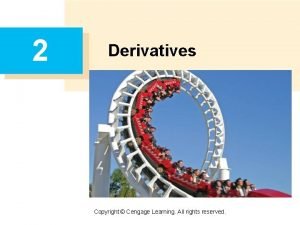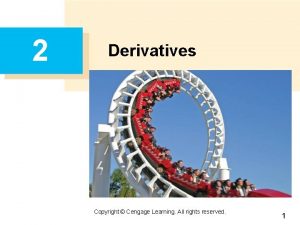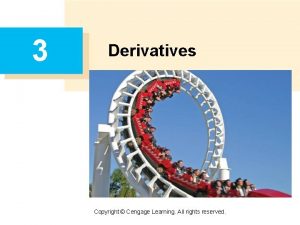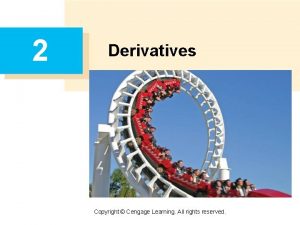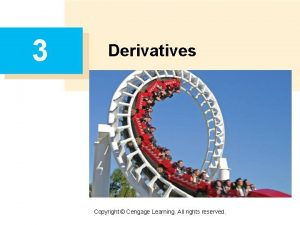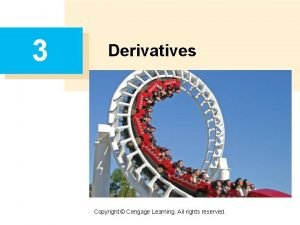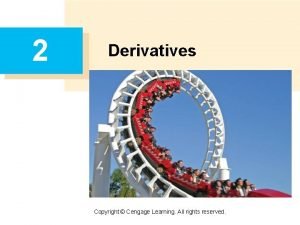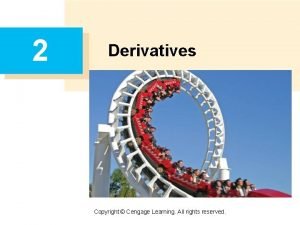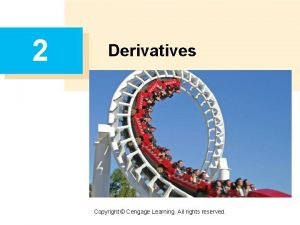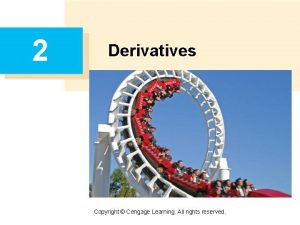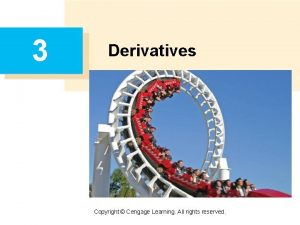3 Derivatives Copyright Cengage Learning All rights reserved












- Slides: 12

3 Derivatives Copyright © Cengage Learning. All rights reserved.

3. 5 Implicit Differentiation Copyright © Cengage Learning. All rights reserved.

Implicit Differentiation The functions that we have met so far can be described by expressing one variable explicitly in terms of another variable—for example, y= or y = x sin x or, in general, y = f (x). Some functions, however, are defined implicitly by a relation between x and y such as x 2 + y 2 = 25 or x 3 + y 3 = 6 xy 3

Implicit Differentiation In some cases it is possible to solve such an equation for y as an explicit function (or several functions) of x. For instance, if we solve Equation 1 for y, we get y= , so two of the functions determined by the implicit Equation 1 are f (x) = and g (x) = . 4

Implicit Differentiation The graphs of f and g are the upper and lower semicircles of the circle x 2 + y 2 = 25. (See Figure 1. ) Figure 1 5

Implicit Differentiation It’s not easy to solve Equation 2 for y explicitly as a function of x by hand. (A computer algebra system has no trouble, but the expressions it obtains are very complicated. ) Nonetheless, is the equation of a curve called the folium of Descartes shown in Figure 2 and it implicitly defines y as several functions of x. The folium of Descartes Figure 2 6

Implicit Differentiation The graphs of three such functions are shown in Figure 3. Graphs of three functions defined by the folium of Descartes Figure 3 When we say that is a function defined implicitly by Equation 2, we mean that the equation x 3 + [f (x)3] = 6 xf (x) is true for all values of in the domain of. 7

Implicit Differentiation Fortunately, we don’t need to solve an equation for y in terms of x in order to find the derivative of y. Instead we can use the method of implicit differentiation. This consists of differentiating both sides of the equation with respect to x and then solving the resulting equation for y . In the examples and exercises of this section it is always assumed that the given equation determines y implicitly as a differentiable function of x so that the method of implicit differentiation can be applied. 8

Example 1 (a) If x 2 + y 2 = 25, find . (b) Find an equation of the tangent to the circle x 2 + y 2 = 25 at the point (3, 4). Solution 1: (a) Differentiate both sides of the equation x 2 + y 2 = 25: 9

Example 1 – Solution cont’d Remembering that y is a function of x and using the Chain Rule, we have Thus Now we solve this equation for dy/dx: 10

Example 1 – Solution cont’d (b) At the point (3, 4) we have x = 3 and y = 4, so An equation of the tangent to the circle at (3, 4) is therefore y– 4= (x – 3) or 3 x + 4 y = 25 Solution 2: (b) Solving the equation x 2 + y 2 = 25, we get y = The point (3, 4) lies on the upper semicircle y = and so we consider the function f (x) =. . 11

Example 1 – Solution cont’d Differentiating f using the Chain Rule, we have So and, as in Solution 1, an equation of the tangent is 3 x + 4 y = 25. 12
 Copyright 2015 all rights reserved
Copyright 2015 all rights reserved Copyright 2015 all rights reserved
Copyright 2015 all rights reserved Dell all rights reserved copyright 2009
Dell all rights reserved copyright 2009 Copyright © 2018 all rights reserved
Copyright © 2018 all rights reserved Copyright cengage learning. powered by cognero
Copyright cengage learning. powered by cognero All rights reserved example
All rights reserved example All rights reserved sentence
All rights reserved sentence Freesound content licence
Freesound content licence Confidential all rights reserved
Confidential all rights reserved Sentinel-controlled loop pseudocode
Sentinel-controlled loop pseudocode 2012 pearson education inc
2012 pearson education inc Microsoft corporation. all rights reserved.
Microsoft corporation. all rights reserved. Microsoft corporation. all rights reserved.
Microsoft corporation. all rights reserved.













